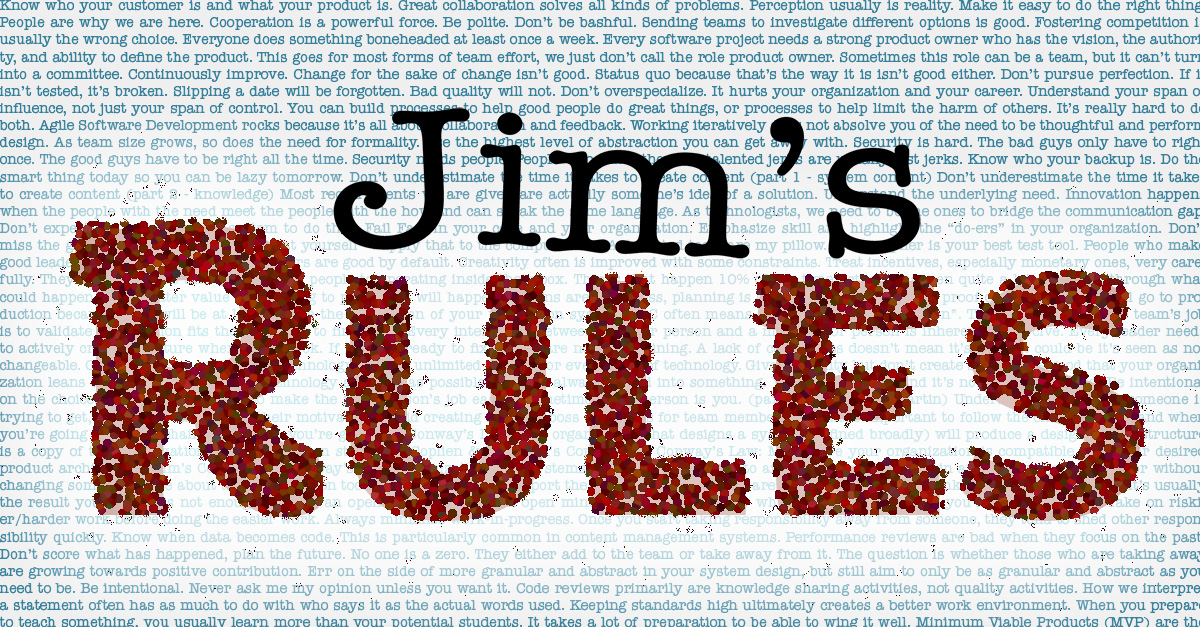Acronym Soup
- Rule 81 - If you don't understand it until you can explain it to your grandmother/an eighth grader/a fifth grader then you don't understand it until you can explain it without jargon, acronyms, and initialisms.
- Rule 82 - A fundamental rule of writing: don't use an acronym without first spelling it out (DUAAWFSPIO). This goes double for your marketing website!

This time around, I will be providing a little writing advice. You are probably thinking, “That’s rich, coming from you.” Annnnyyyyywaaayyy…
We all love our acronyms and initialisms. They are part of the modern world, and we can’t escape them even if we wanted to. We even have an initialism for them: TLAs (Three Letter Acronyms). Unfortunately, they are often confusing. Did you mean Mobile Device Management (MDM), Master Data Management (MDM), Multidimensional Data Modeling (MDM), or Miniature Dwarf Mice (MDM)?
In everyday speech, most of us use the term acronym to refer to both acronyms and initialisms. I’m going to stop being pedantic and do the same for the rest of this article. What’s the difference? Intialism just means taking the letters and making a term. Acronyms are initialisms that are pronounceable. I.e., initialism is the broader term; acronym is a special case of an initialism. Properly, “TLA” would be called an initialism. “HIPAA” is an acronym and thus also an initialism. Both are forms of abbreviation. The rules I’ll discuss below apply to abbreviations too.
Unless you are completely sure that your audience will know what an acronym means, don’t use it. If you are publishing a blog post, do not assume everyone reading that post knows all the acronyms. Maybe they will, but maybe they won’t. If you are creating a marketing site, give your visitors the chance to understand what your product is. Don’t use the industry insider’s term, spell it out!
You may ask, “Do you mean that I should never use an acronym?”
You can use acronyms if you define them. The first time you are going to use the acronym, spell out the phrase1. Put the acronym in parenthesis next to the full phrase and then use the acronym for the rest of the work. Like this:
Most organizations traditionally stored their business data in a Relational Database Management System (RDBMS).
That isn’t a pure acronym. Notice that we ended up with more letters in the acronym than were capitalized in the original term. If you want to be clear about the source of the letters, feel free to capitalize those letters:
Most organizations traditionally stored their business data in a Relational DataBase Management System (RDBMS).
You can even do it like this:
Does anyone use eXtensible Stylesheet Language (XSL) anymore?
You don’t need parenthesis if you are explaining the team directly:
JWST stands for the James Webb Space Telescope.
This goes for web pages, books, presentations, and anything else where you using text. If you are writing a long, nonfiction book with chapters, consider reintroducing the acronym when you have not used it for a long time. If you are speaking, follow the same rule of defining the acronym the first time you use it:
“Hi, Bob! We are here today to talk about CMOS. That is, the Chicago Manual of Style.”
When do you not need to do this? Like I said, when you can very comfortably assume your audience knows the term already. Here are some other cases:
-
The acronym is part of a company’s or product’s formal title.
SQL Server and FedEx are both examples of abbreviations that do not need to be expanded. The SQL in SQL Server stands for Structured Query Language, but Microsoft’s official product name is SQL Server and so “SQL Server” is what you should always use. FedEx formally changed its name from Federal Express to the abbreviation a long time ago because no one used the long name anymore. Getting a logo that is frequently used as a good example of logo design didn’t hurt.
-
When you are creating sufficient context that the exact definition doesn’t matter.
“What are HTML files?” asked Cx531.
“They are files that were used as web pages back in the days of the Internet,” replied Z6c87.
“Oh. They are lost to the Digital Dark Age then.”
“That’s right. We’ll never be able to recover them,” said Z6c87 as it turned to another page in the musty old book.
The above dialog never spelled out that HTML meant HyperText Markup Language, but the context told us all we needed to know.
-
They are part of the jargon of your audience.Umm… no.Explain jargon along with acronyms unless you are 100% sure your audience will be happy to ask a question and that you’ll be happy to answer. I chose MDM as my first example for a reason: I’ve seen too many meetings where the data folks were confused by the infrastructure folks and vice versa, because they both assumed they could fling their jargon around and everyone else would know what they’re talking about.
Worse, I have seen too much marketing material that assumed prospective customers would know what their terms meant. If I’m out on the web looking for MDM solutions and having to sort the MDM solutions from the MDM solutions by clicking on each web page from search results, then I probably will get frustrated quickly as I see the wrong sites over and over again.
It’s one thing if I linked directly into the product’s help docs, it’s quite another when the company’s home page launches right into the acronym soup and never defines anything. You provide 4PL solutions? Great! How is the small business that is just starting to grow to the point they need a partner going to find you when no one in their office knows 4PL stands for “Fourth Party Logistics,” let alone what “Fourth Party Logistics” even means? Break it down unless you really want to stay in the red ocean.
Keep this top of mind in your communications and you will avoid confused readers who don’t know if you are talking about MDM, MDM, MDM, or MDM.
-
You can also use a footnote as long as the footnotes appear in close proximity such as the bottom of the page. Don’t use a footnote if they are going to only appear in an appendix at the end of the work. ↩
